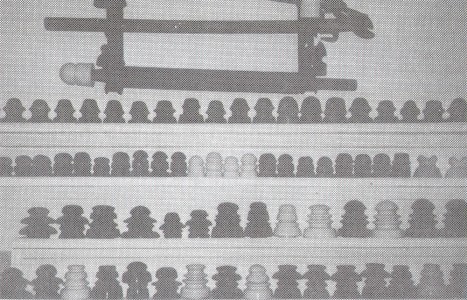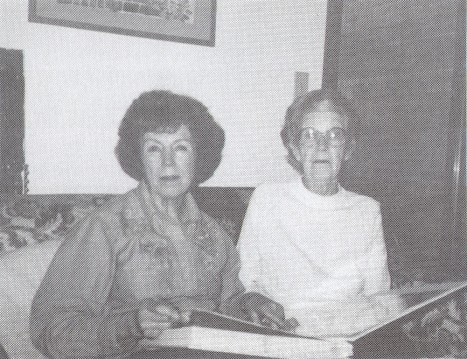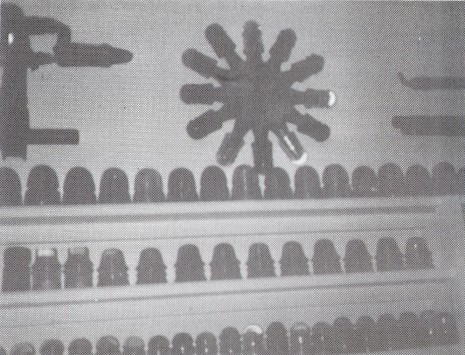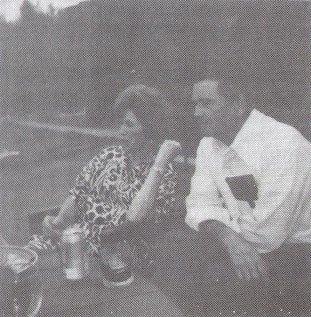Bea Lines
by H.G. "Bea" Hyve
Reprinted from "Crown Jewels of the Wire", March 1992, page 17
JEANNE BRIDGES
"Bea Lines" is going to Oregon this time, to interview one of the
sweetest, if not the very sweetest ladies on earth, Jeanne Bridges. I have known
Jeanne for years, and she is always the same...friendly, hard-working, helpful,
kind, and sweet. To know Jeanne is to love her.
Jeanne first became interested
in collecting insulators in 1963 while living in Bishop, California, a small
town in the Owens Valley, nestled between the White Mountains and the Sierra
Nevadas, at an elevation of 4,135 feet. She had moved to this mountain town to
be near the high country hiking and fishing that she loved so dearly, but she
soon noticed that weather and fishing regulations would keep her out of the
hills during part of the year. So when her assistant (at the automotive parts
store where she worked as a bookkeeper) asked her to go dig old bottles with
her, it seemed like a dandy idea.
Jeanne says, "I had arrived in Bishop
with my young son late in 1963, and this was an activity I could share with him.
Digging and looking for old bottles in the ghost towns of eastern California and
western Nevada was like a treasure hunt, and I could always take home some
pretty hunks of ore when bottles were scarce. Those old mining towns and their
history were fascinating, and it remains a special time in my life.
"I met
Joe Bridges late in 1964, and when he learned of my interest in purple bottles,
he recalled seeing some lavender insulators on a telephone line, and to further
impress me, he suggested we enlist the aid of a friend who worked for the
telephone company and see if we couldn't get a few. I guess that was the first
time I looked at an insulator on a line and really saw it...and sure enough,
there were purple insulators up there. I now know them as CD 160 baby signals
embossed 'California'. In our ignorance, we didn't give any other color a second
look.
"While looking for old bottles along some old narrow gauge railroad
tracks, I discovered some old pole stubs, and thinking I'd find a purple
insulator, I started scratching about in the sand, and found some Brookfield
blob tops. I found their shape interesting, and had worked too hard to leave
them. Besides, we pack rats never go home empty-handed. The wife of our local historian
knew of a line in Nevada that had some truly dark purple insulators, and she
would give us their location if we would bring her enough to decorate a wagon
wheel in her yard.
We checked out the line, and it did indeed have lots of
gorgeous burgundy California signals. There was just one problem, and a big one;
the poles were not climbable. Most of them were very old square redwood poles
ready to topple. Our friend from the telephone company solved this by borrowing
a ladder from work which we could put on top of the pickup's cab, so we could
reach those jewels. We also found a marvelous old watering hole with the great
name of 'Cowboy and Helen's' . It had a great old back bar featuring a huge
mirror, which had come around to the west coast by sailing ship and across the
desert by wagon. It was a real treasure, but wasn't for sale.
"By this
time, I was really hooked by the insulator bug, and was told about a line in
Nevada that was down and had some odd-shaped insulators on it, but it would
require four-wheel drive to get there. By this time Joe and I were getting to
be an 'item'. So, since he couldn't get off that weekend, he was willing to lend
me his pickup. That was all I needed to hear. I gathered up my bottle-digging
friend from work, and we were off for the wilds of Nevada...and it was a bit
wild...with lots of range bulls that were protective of their territory; and
rattlesnakes.
"Those odd insulators were CD 196 transpositions. We
managed to find some perfect ones and were thrilled beyond belief; then we set
our sights on bigger game. Each pole had been topped by a huge porcelain power
insulator, and we decided we had to have a pair of those. They were bolted down,
and we paid a price to get them...bruised and bleeding knuckles. In time,
crawling across the high desert took its toll in gas, and we had to head for
Tonopah and a fresh supply. We finished the day by digging in the old Tonopah
dump, and I found a small bisque doll -- a black child in a white shift eating
watermelon -- a real jewel that I still own.
"While bottle digging near the
old town of Manhattan, Nevada, I noticed some big glass insulators on an old
line in the middle of nowhere, and convinced Joe that they were essential to my
happiness. He was agreeable to climbing for a few -- they were heavy -- (like Locke
16' s), and they were the start of our power collection.
"A few antique
stores would have an insulator or two, and we traded some of our surplus
Californias for other SCA insulators; it never occurred to us to buy one. By
this time I had the insulator bug so badly that I bribed Joe and his friend into
climbing for me by packing great picnic lunches, and the cold beer was a big aid
in getting them up those poles. I don't recall how I got in touch with Marion
Milholland, but we did some insulator swapping by mail, which was great fun, and
he told me about this book on insulators that he was putting together. It
sounded like just what I needed to guide me, and indeed it was. It was published
about the same time that Joe and I were married -- 1967 -- two good beginnings.
"We moved to Arlington, Washington, in 1969, and the insulators came with
us. We didn't have a room we could devote to insulators, so they were scattered about the house. Joe has always been a big help in obtaining and
displaying insulators, but when we moved to Arlington, I found out what his real
love was; vegetable gardening. I soon found myself helping with the garden that
grew to such proportions that we could have fed the whole town, and indeed we
tried, after I filled the freezer and all of my canning jars.

A few pieces of the porcelain collection.

Two real sweeties -- Jeanne Bridges and Evelyn Milholland
"In 1979 we
moved to Marysville, which was closer to Joe's work with the Snohomish County
PUD, where he was employed as a line foreman. We decided to convert a corner of
the garage into an insulator room, which turned out to be a learning experience
for both of us, and we muddled through. It turned out great in spite of our
ignorance, and we so enjoyed having all of our insulators together. Joe had this
terrific idea of using the space above the insulators to display the old
wooden-handled line tools; it was an inspired thought, and the linemen
especially enjoyed them. Another little treasure that seemed to please everyone
was a clock made from old oak insulator pins with an insulator on each hour.
Dick Vaughn made this one, and I was lucky enough to win it at one of our shows.
Gary Reed of Penticton, Canada, made the first one seen in our area, and Dick
was talented enough to follow Gary's example. I used ponies on mine and aimed
for color -- and indeed it was a colorful and unique addition to the room.
"At
last, having our insulator room, our insulator friends could see our
'treasures'. We were lucky enough to have Andy and Violet Brown encouraging us,
and when they started with the small shows, it gave us a chance to see other collectors. As the shows grew larger, I was happy to help the Browns put them
on. I do get a lot of teasing about my hobby from my non-insulator friends who
don't understand devoting so much time, effort, and space to 'hunks of glass',
although they do concede that some of the colors are pretty.

Clock made form oak pins and ponies, and part of the glass collection
"I also took a
lot of teasing about my chickens. When we moved to Marysville, Joe noticed this
run-down chicken house out back, and the thought of fresh eggs set him to
refurbishing the building. I bought a couple of hens with chicks, and the fun
started -- and our friends started giggling -- and with good reason. Such pampered
birds -- we even had an old hen's graveyard, as those hens never saw a stew pot
-- they died of overeating or old age. I even taught our blind hen Gertrude to
ride in a wheelbarrow and she loved it." The faster I went, the better she
liked it, and she held her head high to feel the breeze. And yes, people did
stop to see this; we were a traffic hazard."
After 20 years with the PUD,
Joe decided it was time to retire and look for a home. His last day was April
30, 1990, and they started their quest in June. They decided on Joseph, Oregon,
a small town in the northeast part of the state close to the Eagle Gap
Wilderness. Jeanne continues, "We wanted to get away from traffic and
crime. Did we ever! There isn't a traffic light in the whole county, and not a
policeman in town; we don't have any crimes to solve. We decided to bring our
collection with us, even though it would be a big task, as we have around 1,300
glass pieces and 800 porcelain. We have our home and are enjoying having a
stream as a boundary. We are hoping to find an insulator or two of interest in
some nook or cranny of this area, that will be special to us.

Jeanne and Joe Bridges
"We have spent the first year putting in a
yard -- turning the house into a home, and exploring some of this country. We
can certainly understand why Chief Joseph and his Nez Perce tribe chose this
land of 'Winding Water' for their home. I have had a wonderful time hiking the
high country and Joe enjoys his daily visits with the old timers for 25 cents
coffee at a local cafe. Life is indeed good. And now we have started our new
insulator room, so it will be even better. It is really a minihouse. The walls
are up, the windows in, and it has a roof, but the inside doesn't have a wall;
but that is winter's work. We are putting power in and painting the outside so
it will be ready for the snow. Come spring we should have the collection in and
ready for viewing, and are looking forward to the pleasure this will give
us."
Jeanne is too modest and didn't mention all of
the things she does for our hobby. She has authored and coauthored many show
reports for both the local shows and the national show in her area. She is a
great writer, and does interesting reports that don't just give statistics, but
tell a story along with it. (In fact, she very ingeniously answered my
questionnaire for "Bea Lines" in story form, leaving very little for
me to do but copy it.) She has also cohosted many shows, and several times has
driven alone to the Bakersfield show. So it was no surprise to those of us who
know Jeanne when her efforts were recognized at the national in 1990. She says,
"We feel the hobby has been good to us, and I was rewarded at the national
in Portland for what I've been able to do to help the hobby. Steve Watkins
presented the Lon Holy Award for Dedication to the Hobby...a set of 'End of Era'
No.2 Columbia commemoratives, and the colors are gorgeous. Now if I could just
find that Gregory I've coveted for so long, life would indeed be sweet."
|
